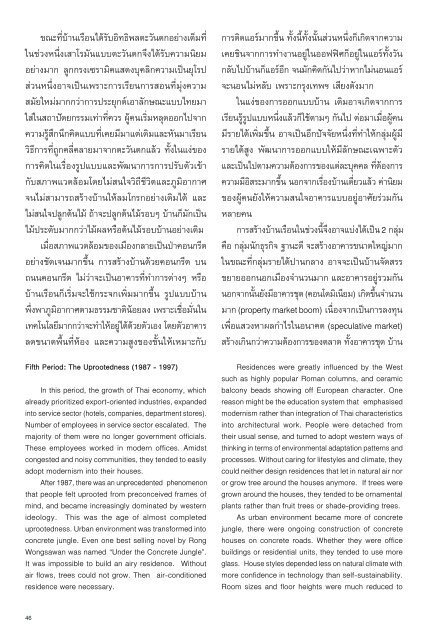บ้านเรือนถิ่นไทยในช่วงเจ็ดทศวรรษ 2489-2559
Create successful ePaper yourself
Turn your PDF publications into a flip-book with our unique Google optimized e-Paper software.
ขณะที่บ้านเรือนได้รับอิทธิพลตะวันตกอย่างเต็มที่<br />
ในช่วงหนึ่งเสาโรมันแบบตะวันตกจึงได้รับความนิยม<br />
อย่างมาก ลูกกรงเซรามิคแสดงบุคลิกความเป็นยุโรป<br />
ส่วนหนึ่งอาจเป็นเพราะการเรียนการสอนที่มุ่งความ<br />
สมัยใหม่มากกว่าการประยุกต์เอาลักษณะแบบไทยมา<br />
ใส่ในสถาปัตยกรรมเท่าที่ควร ผู้คนเริ่มหลุดออกไปจาก<br />
ความรู้สึกนึกคิดแบบที่เคยมีมาแต่เดิมและหันมาเรียน<br />
วิธีการที่ถูกคลี่คลายมาจากตะวันตกแล้ว ทั้งในแง่ของ<br />
การคิดในเรื่องรูปแบบและพัฒนาการการปรับตัวเข้า<br />
กับสภาพแวดล้อมโดยไม่สนใจวิถีชีวิตและภูมิอากาศ<br />
จนไม่สามารถสร้างบ้านให้ลมโกรกอย่างเดิมได้ และ<br />
ไม่สนใจปลูกต้นไม้ ถ้าจะปลูกต้นไม้รอบๆ บ้านก็มักเป็น<br />
ไม้ประดับมากกว่าไม้ผลหรือต้นไม้รอบบ้านอย่างเดิม<br />
เมื่อสภาพแวดล้อมของเมืองกลายเป็นป่าคอนกรีต<br />
อย่างชัดเจนมากขึ้น การสร้างบ้านด้วยคอนกรีต บน<br />
ถนนคอนกรีต ไม่ว่าจะเป็นอาคารที่ทาการต่างๆ หรือ<br />
บ้านเรือนก็เริ่มจะใช้กระจกเพิ่มมากขึ้น รูปแบบบ้าน<br />
พึ่งพาภูมิอากาศตามธรรมชาติน้อยลง เพราะเชื่อมั่นใน<br />
เทคโนโลยีมากกว่าจะทาให้อยู่ได้ด้วยตัวเอง โดยตัวอาคาร<br />
ลดขนาดพื้นที่ห้อง และความสูงของชั้นให้เหมาะกับ<br />
Fifth Period: The Uprootedness (1987 - 1997)<br />
In this period, the growth of Thai economy, which<br />
already prioritized export-oriented industries, expanded<br />
into service sector (hotels, companies, department stores).<br />
Number of employees in service sector escalated. The<br />
majority of them were no longer government officials.<br />
These employees worked in modern offices. Amidst<br />
congested and noisy communities, they tended to easily<br />
adopt modernism into their houses.<br />
After 1987, there was an unprecedented phenomenon<br />
that people felt uprooted from preconceived frames of<br />
mind, and became increasingly dominated by western<br />
ideology. This was the age of almost completed<br />
uprootedness. Urban environment was transformed into<br />
concrete jungle. Even one best selling novel by Rong<br />
Wongsawan was named “Under the Concrete Jungle”.<br />
It was impossible to build an airy residence. Without<br />
air flows, trees could not grow. Then air-conditioned<br />
residence were necessary.<br />
การติดแอร์มากขึ้น ทั้งนี้ทั้งนั้นส่วนหนึ่งก็เกิดจากความ<br />
เคยชินจากการทางานอยู่ในออฟฟิศก็อยู่ในแอร์ทั้งวัน<br />
กลับไปบ้านก็แอร์อีก จนมักคิดกันไปว่าหากไม่นอนแอร์<br />
จะนอนไม่หลับ เพราะกรุงเทพฯ เสียงดังมาก<br />
ในแง่ของการออกแบบบ้าน เดิมอาจเกิดจากการ<br />
เรียนรู้รูปแบบหนึ่งแล้วก็ใช้ตามๆ กันไป ต่อมาเมื่อผู้คน<br />
มีรายได้เพิ่มขึ้น อาจเป็นอีกปัจจัยหนึ่งที่ทาให้กลุ่มผู้มี<br />
รายได้สูง พัฒนาการออกแบบให้มีลักษณะเฉพาะตัว<br />
และเป็นไปตามความต้องการของแต่ละบุคคล ที่ต้องการ<br />
ความมีอิสระมากขึ้น นอกจากเรื่องบ้านเดี่ยวแล้ว ค่านิยม<br />
ของผู้คนยังให้ความสนใจอาคารแบบอยู่อาศัยร่วมกัน<br />
หลายคน<br />
การสร้างบ้านเรือนในช่วงนี้จึงอาจแบ่งได้เป็น 2 กลุ่ม<br />
คือ กลุ่มนักธุรกิจ ฐานะดี จะสร้างอาคารขนาดใหญ่มาก<br />
ในขณะที่กลุ่มรายได้ปานกลาง อาจจะเป็นบ้านจัดสรร<br />
ขยายออกนอกเมืองจานวนมาก และอาคารอยู่รวมกัน<br />
นอกจากนั้นยังมีอาคารชุด (คอนโดมิเนียม) เกิดขึ้นจานวน<br />
มาก (property market boom) เนื่องจากเป็นการลงทุน<br />
เพื่อแสวงหาผลกาไรในอนาคต (speculative market)<br />
สร้างเกินกว่าความต้องการของตลาด ทั้งอาคารชุด บ้าน<br />
Residences were greatly influenced by the West<br />
such as highly popular Roman columns, and ceramic<br />
balcony beads showing off European character. One<br />
reason might be the education system that emphasised<br />
modernism rather than integration of Thai characteristics<br />
into architectural work. People were detached from<br />
their usual sense, and turned to adopt western ways of<br />
thinking in terms of environmental adaptation patterns and<br />
processes. Without caring for lifestyles and climate, they<br />
could neither design residences that let in natural air nor<br />
or grow tree around the houses anymore. If trees were<br />
grown around the houses, they tended to be ornamental<br />
plants rather than fruit trees or shade-providing trees.<br />
As urban environment became more of concrete<br />
jungle, there were ongoing construction of concrete<br />
houses on concrete roads. Whether they were office<br />
buildings or residential units, they tended to use more<br />
glass. House styles depended less on natural climate with<br />
more confidence in technology than self-sustainability.<br />
Room sizes and floor heights were much reduced to<br />
46


















